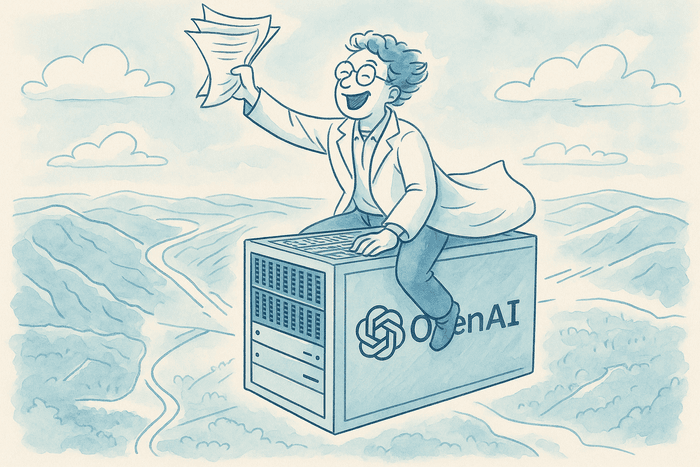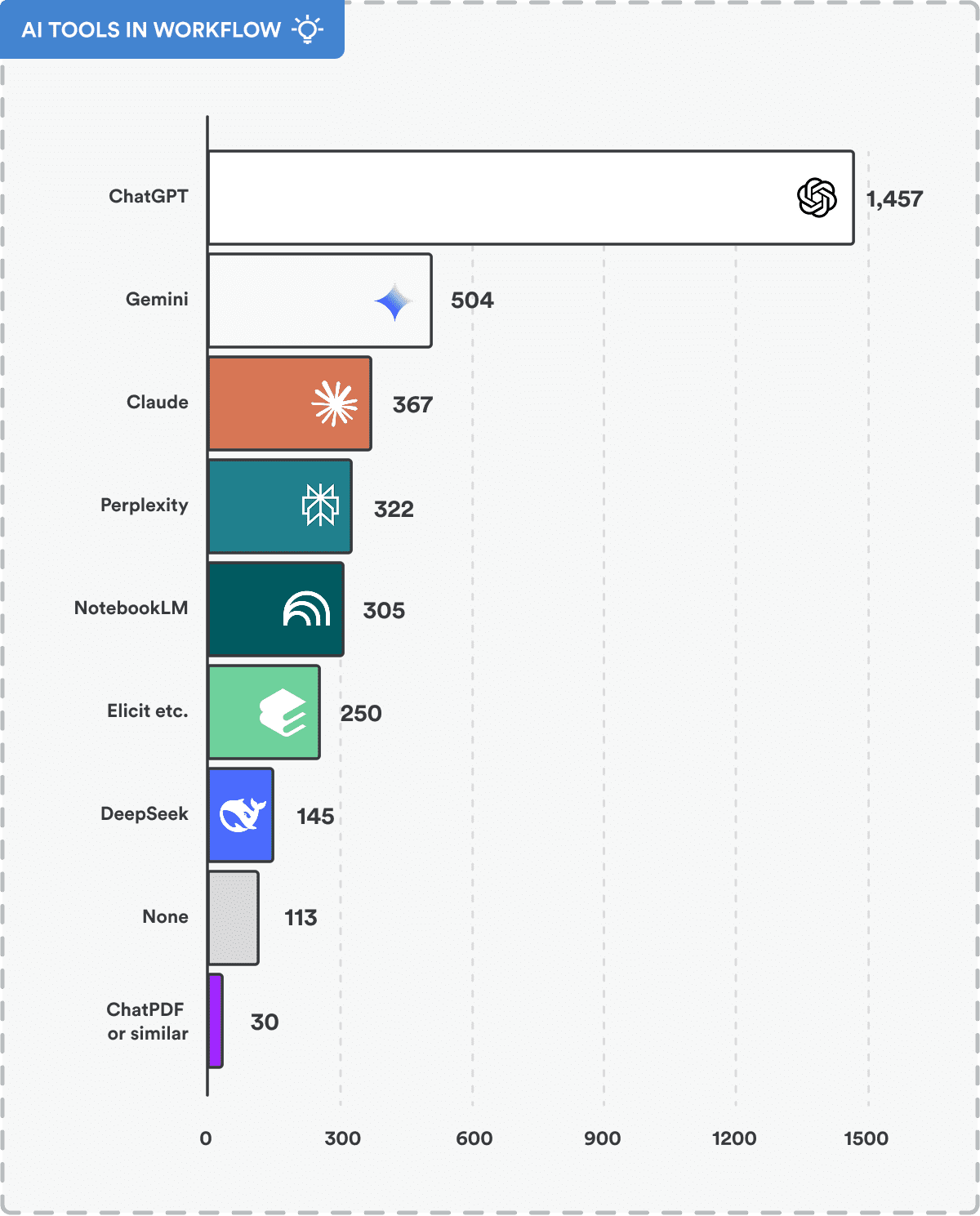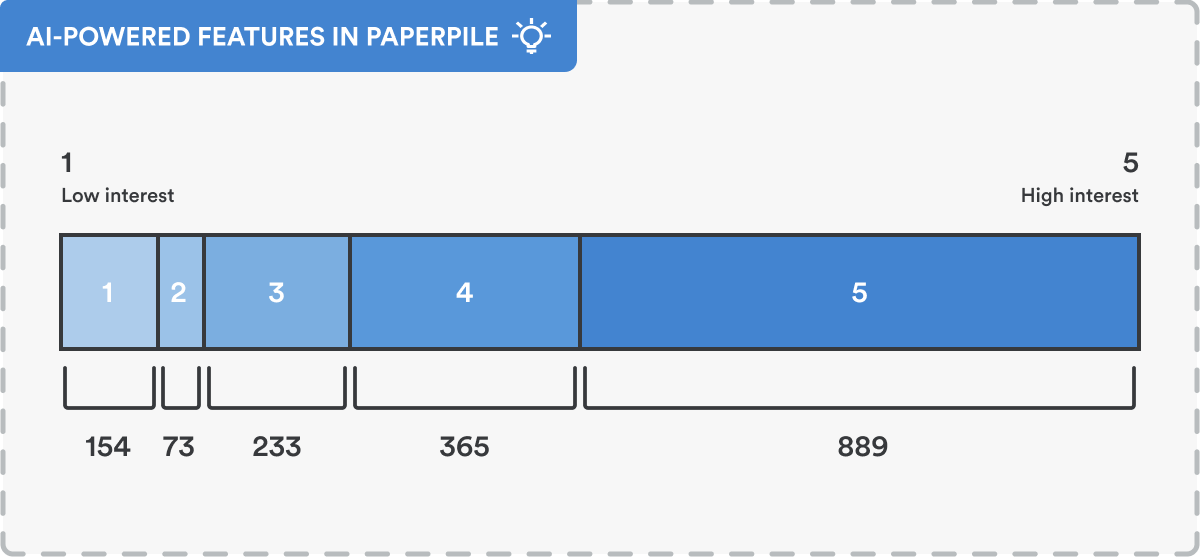
Paperpile stands out as one of the few products without AI features in 2025.
But that’s going to change soon! We’ve got a plan to leverage AI without our product losing its soul.
Here’s the story of why we gathered real data on what researchers want from AI, what we learned (spoiler alert: they use it extensively and are enthusiastic about its potential), and how Paperpile will remain focused on making it easier to find, read and write papers—even as we enter a new era of ubiquitous AI-powered tools.
AI, the inevitable
When LLMs and the AI revolution transformed the world in 2023, we made a conscious decision not to hastily implement a me-too AI button or launch yet another basic ChatWithPDF clone.
This caution was supported by our mixed experiences with AI features in everyday software tools, such as our accounting software. Features felt half-baked or bolted-on. Most failed to deliver even a sliver of value beyond the existing mature software product. (No, I would not like to chat with my invoices!)
However, more recently we’ve seen how quickly our marketing and engineering teams are integrating tools like ChatGPT into their daily work lives. Teammates started leveraging AI for coding, copyediting, UX mockups, and image generation. Conversations with scientists and academics in our lives further confirmed: the mass adoption of AI tools in research is an inescapable trend. And it’s accelerating as large language models get smarter, faster, and cheaper over time.
By early 2025 it was obvious: we needed to figure out how scientists use AI in their work and what Paperpile can do to help.
Survey says…
To guide our plans, we wanted to look beyond the hype—to understand the real-world use cases, benefits, and concerns that practicing researchers have regarding AI in research.
Fortunately, Paperpile has a thriving community of many thousands of experts who rely on best-in-class tools to support their work. So we surveyed our users:

Some results aligned with our expectations. Other findings surprised us, including the extent to which one mainstream tool looms above all the rest.
Tools of the trade
We first developed a baseline understanding of which AI tools are most widely used by researchers today:

Wow: ChatGPT is ahead by a mile, with almost triple the usage of Gemini. A long tail of other tools follow behind.
This isn’t surprising, as ChatGPT is the clear market leader among general-audience AI chatbots. But it does underscore the notion that researchers’ use of AI tools is broadly similar to the general population. While researcher-specific tools may offer some unique value to science, it’s not yet compelling enough to overcome the distribution and brand awareness advantage of the mainstream AI chatbots.
At Paperpile we understand the diversity of researchers’ individual workflows, so we always pay close attention to the long tail of tools and diverse ways of working. This leads us to the middle cluster of tools: Perplexity, NotebookLM, and the new breed of AI-powered literature search apps. While their specific features vary, a common thread between these researcher-focused apps is that they emphasize traceability of citations back to the source, even for AI-generated output. This is obviously well-aligned with the academic mindset. We expect detailed traceability will become very widespread in research-focused AI products, and may even become more prominent in general-purpose tools like ChatGPT.
We also find it comforting, in a way, that very few researchers reach for ChatPDF or other low-effort “chat with my PDF” apps. As everyone who’s been through a Ph.D. knows, true insight comes from synthesizing ideas across papers and research fields. Not just from asking questions of a single source. We see more value in the growing long-context capabilities of AI models like Google’s Gemini, which can now reference dozens of full-text papers in a single chat session. We’re also excited by apps that enable accurate AI-powered searches across a wide body of sources, such as NotebookLM, Elicit and Litmaps.

For a deeper dive into two modern tools for surveying the literature, check out a recent webinar co-hosted by Paperpile and Litmaps: Master Literature Review: A Hands-on Workflow with Litmaps and Paperpile.
How researchers use AI today
Next we asked users how AI supports their work today:

Unlike the first question, here there is no single dominant answer. Instead we find researchers use AI to enable a broad range of research-relevant tasks.
tl;dr: summarizing academic literature
Summarization is one of the more compelling applications of AI in academic literature, so it makes sense that it was the most highly-valued among researchers.
Language models were pretty good at summarization even before ChatGPT launched, and the recent breed of long-context, deep-thinking models are incredible at distilling complex documents into a few pithy sentences.

Product innovators are picking up on this capability: you can now find AI-generated summaries in the Semantic Scholar, Alphaxiv, and Hugging Face search engines. (Semantic Scholar has an informative write-up on their approach to paper summarization.) This paradigm will almost certainly become more widespread over time.
Where can tools like Paperpile help improve the experience? One answer is customization: the perfect summary of a paper likely depends on the field of study, your career stage, and the context in which you’re reading or citing the work. Rather than provide a one-size-fits-all summary style, we aspire for Paperpile to generate relevant, context-aware, controllable summaries that specifically support your research.
Here’s a quick recipe for academic reference summarization.
- Visit https://chatgpt.com and select a model with advanced reasoning.
- Upload the PDF of a paper you recently discovered or read.
- Ask ChatGPT to “Summarize the discussion section in no more than five sentences. Separately, list 2-3 bullet points of follow-up work suggested by the authors.”
Try customizing the prompt to be more specific to your interests or field.
You may be surprised at the result!
Search: where did I leave my /citekeys?
Search is a more nuanced topic. We were surprised to learn that many researchers use AI to search and discover papers, since it’s well known that ChatGPT can hallucinate citations and sources. The largest models also tend to have a knowledge cutoff date that’s several months in the past, potentially creating gaps in their knowledge of recent work.
On the other hand, ChatGPT recently upgraded its search and browse capabilities. And all major AI chatbots now support so-called Deep Research mode where the AI works in the background, running web searches and chat sessions for up to several minutes before outputting a detailed report. These innovations make it increasingly feasible to ask an AI chatbot about a fast-moving research field and get up-to-date, well-referenced results.
The upshot: these models and the products built around them are improving quickly, so be ready to adjust your mental model of what’s possible fairly frequently.
New apps are also emerging that use AI to search deeper and more thoroughly through the academic literature than your typical PubMed or Google Scholar search, such as Ai2 Paper Finder, Futurehouse, and Undermind.
On a product level, we suspect that searching in Paperpile may eventually separate into two distinct features supporting different goals:
- Paper lookup and library search. When you know the title or authors of a paper and want to quickly import, read, or cite it. Users expect a quick response (a fraction of a second) and accurate matching.
- Deeper, semantic search and exploration. When you remember only vague details of a paper (like the methods used or the high-level conclusion) or when you’re looking to expand your reading list on a subject. Users are willing to wait longer (tens of seconds up to a minute) for a more comprehensive set of results. Here, LLMs have potential to help with query generation and ranking and classification of results.
OpenAI, closed access
One constraint for both the summarization and discovery use cases is that AI-powered services generally can’t access paywalled articles. This limits their ability to deeply interrogate the scientific literature.

Solutions to this problem can come from two directions.
On one side, AI services can negotiate deals to gain access for their systems to read paywalled content. We see some evidence of this happening: Google Scholar has long indexed closed-access content, and newer AI-powered services like Semantic Scholar and OpenEvidence have signed partnerships and content deals with key publishers to make closed-access content accessible to their AI-powered search.
On the other side, tools can make it easier for researchers to bring their personal full-text PDFs into the chat session. For example, Gemini Deep Research just added support for file uploads, which ChatGPT has supported for awhile now. This means you can upload your meticulously-collected PDFs to guide the AI’s agent-like research and report generation flow.
Reference management tools like Paperpile have a strong role to play here, too, since they act as a repository of the papers you’ve read and notes you’ve taken in the course of a research project. Paperpile will soon make it easier to send full-text papers to your AI tool(s) of choice, saving you time and improving the utility of ChatGPT for your research.
Embracing the lingua franca with translation
The next set of common applications of AI in research are related to language:
- Improve or copy-edit my English
- Translate papers to my language
- Critique or peer review my writing
- Write sections of papers or grants
Science is a global pursuit whose agreed-upon universal language is English. This means that for many scientists and humanities researchers, the path to success in the global community is to read and write in your non-native language. To that end, the incredible copy-editing and translation capabilities of modern AI can be an empowering force for researchers who might otherwise struggle with comprehension or writing.
Indeed, we see evidence from the survey that respondents from non-English speaking countries value the language-related applications of AI more highly than other respondents.
Deep critique: AI as a partner in thought
Pushing out toward the extremes of what AI is capable of today, some researchers use LLMs to critique their work directly, in what you might call AI-powered pre-submission peer review.
In our experience, the power of the model matters a lot here, and major improvements have been made in the past 6 months or so. If you last tried asking ChatGPT to review a grant or paper a year ago, try today with a state-of-the-art model like OpenAI o3 or Gemini 2.5 Pro. The recent introduction of “thinking” processes to these models has significantly improved their ability to engage with complex, nuanced concepts across a larger body of work.
For more ideas on academic writing with AI, we enjoyed this practical guide put together by Arjun Raj. Thanks to the survey respondent who shared it with us!
Here’s a quick recipe for asking ChatGPT to critique your paper or draft manuscript:
- Visit https://chatgpt.com.
- Upload the PDF of a recent paper you authored or an in-progress manuscript.
- Ask ChatGPT to “Peer review this paper: provide a rational, evenhanded critique of the strengths, weaknesses and inherent limitations of this paper. Suggest specific improvements or extensions to this work that would make it more acceptable to peer reviewers from this field of study.”
Note: be sure to use a “smart” model for this task: OpenAI o3 or Gemini 2.5 Pro.
Anti-AI sentiment is small but mighty
Overall, our community is enthusiastic at the prospect of Paperpile adding AI-powered capabilities to improve their research workflow:

However, there is a small but passionate segment (5-10%) who feel strongly that AI does not belong in a product like Paperpile or in academic workflows altogether.
This contingent of Paperpile customers spans a broad range of disciplines and geographies. In their free-text responses, they share a diversity of motivating factors:
- Risk of hallucinations and inaccuracy
- De-skilling of academic trainees
- Copyright and labor implications
- Environmental impacts
- Data privacy and security
Some paraphrased quotes from respondents to our survey:
“Keep it simple. Keep people employed, don't replace with AI”
“AI has no place within research.”
”Don't sprinkle AI dust all over everything.”
”I will stop using a product the moment it introduces AI features.”
”I am ethically opposed to generative AI due to ecological concerns, copyright issues, and labor implications”
Here’s our view: AI brings incredible promise, but it also poses real risks to society, especially during this period of rapid change. We’ll take these concerns to heart while staying focused on practical ways Paperpile can deliver value to a wide audience of researchers and scientists. With regards to AI-powered features, we will continue our longstanding practice of putting control in the hands of our expert users, including those who do not wish to interact with AI at all in Paperpile.
Caveats and limitations
It’s important to qualify these results by noting they come from an in-app survey of active subscribers of the Paperpile product. Compared to the global set of all researchers, our results may be skewed in terms of demographics, user persona, and skill level. However, we were encouraged by the survey response rate (> 20%) and the strong breadth of academic disciplines and career stages represented by our respondents.
What’s ahead
As a team of researchers-turned-toolbuilders, we are equal parts excited, mystified, and at times overwhelmed by the pace of advancement in AI. And it’s clear that the amount of interest, concern, and overall impact on research from AI will increase over time.
Regardless of how quickly AI gains dominance as a tool (or a crutch!) for research progress, we at Paperpile remain squarely in pursuit of our longstanding mission: building tools for scientists and academics to make their work easier, more enjoyable and ultimately more successful. This requires finding, reading, and writing academic papers with accuracy, efficiency and depth.
Here are the key principles that will guide future development of AI-powered features and integrations in Paperpile:
- Prioritize useful features, not AI itself. Any AI-powered feature we add will be justified solely on the basis of how much it improves the tasks and workflows Paperpile is designed for.
- The user is in control. AI features and AI-generated content will be clearly identified as such, and can be completely turned off. We respect the diversity of opinions on the use of AI in research, including categorical rejection.
- Integration and openness. Avoid product lock-in and opaque wrappers around AI models. For example, if our users already use (and pay for) ChatGPT, Paperpile will integrate with ChatGPT to enhance the value of their investment in that platform.
With these principles to guide us, we see plenty of potential for AI-powered tools to continue the trajectory of computers and software tools as bicycles for the mind. We are motivated to continue earning our users’ trust by making reading and writing papers dramatically easier and less stressful.
I hope to share more updates on Paperpile’s new features in the weeks ahead!

Gregory Jordan (LinkedIn, Twitter) is an engineer and product leader with experience spanning biology, health tech and data science. In 2012 he received a Ph.D. in computational biology from Cambridge University and cofounded Paperpile with Stefan and Andreas.
Greg later pursued a career at Google and Alphabet as an engineer and manager. With Terra, All of Us, and Verily Workbench he built products and platforms for data governance, cloud analysis, and AI enablement for data scientists.
Now back at Paperpile, Greg is leading the company’s product and commercial efforts with a focus on enterprise, biopharma and AI. His mission on team Paperpile? To empower researchers with the best imaginable tools to drive science forward.